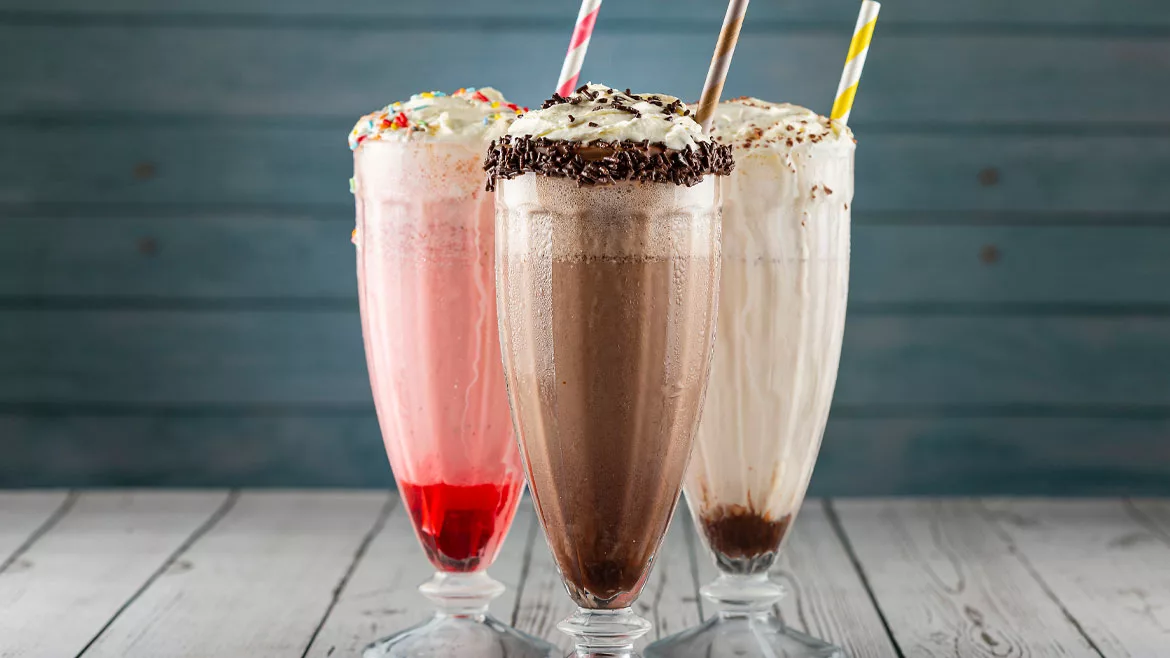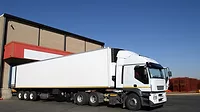Innovations in Trucks and Trailers
![]()
Innovations in Trucks and Trailers
by RICHARD MITCHELL
In the realm of beverage
distribution, safety and comfort equate to efficiency. Drivers who are able
to remain vigorous throughout their deliveries not only are more
productive, but also are less likely to be involved in traffic accidents
and other mishaps.
And manufacturers of trucks and trailers are keeping
driver needs in mind as they design new models and upgrade features on
current product lines.
The Hackney International Division of Specialized
Vehicles Corp., for instance, is working to make its bodies and trailers
more driver-friendly by concentrating on ergonomic upgrades for 2005.
Hackney is incorporating the “Power Hand Grip” internal grab
bar, which has more than 2 feet of grip length, is closer to the outside of
the body, and designing it to eliminate interference with drop shelves.
To make it easier for drivers to enter vehicles,
Hackney is building a step into the bottom of its trailer platforms, and
situating a recessed handgrip inside the door track. The bottom rail, which
also was lowered by 6 inches for simpler entry to the trailer, has a
slip-resistant surface and is reinforced to protect against possible damage
from forklifts.
The newer design offers an alternative to the
traditional configuration of steps that are bar welded to the outside of
bodies and trailers, and then pulled down and swung into place for use,
says Hodges Hackney, president of Washington, N.C.-based Hackney
International. A pullout step in the platform remains an option.
“Ergonomics in the body and trailer — the
work portions of the truck — also are going to be the driving force
behind future vehicle selection,” Hackney notes. “Bottlers that don’t include ergonomic features
will receive complaints from workers, or at the very least, workers will
complain to OSHA (the U.S. Department of Labor’s Occupational Safety
and Health Administration), who in turn will mandate that the units be
retrofitted for safety. It is a very critical area and government
regulators are going to make sure designs are as secure as
possible.”
Other Hackney International upgrades are intended to
make equipment more durable. Enhancements include the use of LED lights
that are designed to function for 100,000 hours, which typically will be
the life of the trailer, Hackney says. The lights are sealed in epoxy, are
less susceptible to shock and vibration, and require low amounts of
current. A sealed wiring harness system that connects to the lights is
resistant to moisture and also will last 20 or more years, he notes.
Longevity also is the objective behind Freightliner
LLC’s use of the Mercedes-Benz Automated Gear Shift (AGS)
transmission for its Freightliner Business Class M2 vehicles. The AGS,
which is scheduled to go into production this summer for the 2005 models,
features a two-pedal, automated clutch actuation system.
Because the AGS automatically manages all gearshifts,
it is expected to significantly extend the life of the clutch and
transmission. The elimination of manual shifting also will make it easier
for companies to hire drivers because less skill is required to operate the
trucks, says Tanya Appuhn, market segment manager for Portland, Ore.-based
Freightliner LLC’s Freightliner Trucks division.
Automated transmissions are particularly effective for
beverage vehicles because of the frequent stops and starts of trucks during
deliveries, she notes. Manual clutching and shifting adds to worker
fatigue, which can reduce driver performance, she says.
Other ergonomic elements include a lower floor height
so drivers can more easily access cabs, wider and taller doors, and
numerous grab handles.
“Just lowering the floor height by a few inches
can save drivers from climbing an extra 10 feet a day if they constantly
get in and out of the vehicles,” Appuhn says.
Freightliner also lengthened the cab and shortened the
hood of its trucks for more interior room. And a lower hood slope enables
drivers to see closer to the front of the truck, reducing the chance of
collisions in tight loading dock and delivery areas, she notes.
Electrical components, as well as fuel and air tanks,
also can be situated under the cab so vehicle frames can more easily be
altered to support beverage bodies, Appuhn says. “Beverage
companies’ needs were considered in developing the M2,” she
adds.
Cab upgrades also are among the enhancements to
Dearborn, Mich.-based Ford Motor Co.’s F-650 chassis and F-750
chassis vehicles. Ford’s “SuperCab” configuration, which
is 50 percent larger than a standard cab, contains a foldable back seat
with separate doors to access that rear area.
Large space behind the back seat enables drivers to
store sales materials, point-of-purchase displays or even a dolly, says Lew
Echlin, marketing manager, Ford Division, Commercial Truck. “Being
able to store items in the cab can create room for about another 99 cases
of beverages in the back of the truck,” he notes.
The F-650 and F-750 are medium track, Class 6 and 7
vehicles available in straight truck or tractor formats, and are geared
specifically for the beverage industry, Echlin says.
Ford also will soon be marketing the LCF, or low cab
forward, a 2006 model that is scheduled to be available in the first
quarter of 2005. Among the expected features are gross vehicle weight rates
and payloads that Echlin says will be among the
highest available in Class 4 and Class 5. The gross vehicle weights (GVW)
rating is the sum of the vehicle, occupants’ weight and total
payload.
The payload for the Class 5 LCF is set to be more than
13,000 pounds, and the gross combined weight ratings for the truck payload
and trailer will be over 26,000 pounds, he says.
“Workers overload their trucks beyond the vehicle
rating, which causes an incredible amount of wear and tear that runs not
only through the shocks and springs, but also the transmission and
engine,” Echlin says. “Companies often buy a 9,000-pound
payload truck for a 13,000-pound load and pray for the best.”
Designed for use in highly populated urban areas, the
LCF also will have a 200 horsepower V6 engine and a 16.5-foot turning
radius, which Echlin says is expected to be among the lowest in the class.
“Turning radius is probably the most important
concern of beverage delivery drivers that have to navigate through
alleys,” he adds. “Just one half of an inch is often the
difference between making the turn or having to throw the truck in reverse
to do a T-turn, which places more wear and tear on the
transmission.”
Maneuverability upgrades, as well as durability and safety enhancements, also were added by Denton,
Texas-based Peterbilt to its Model 335 vehicles that are available in Class
6 and 7 truck and tractor configurations.
The revised design includes a sloping aerodynamic,
stainless steel hood that is lighter and provides greater visibility than
previous models. The hood’s polycarbonate crown is made of the same
material as hockey rink glass for added strength, says Erik Binns,
Peterbilt medium-duty marketing manager.
Visibility improvements include a standard rear truck
window that is 53 percent larger than before, and optional rear corner
windows. Mirrors that previously were mounted on doors now are in more
forward positions on the cab to reduce driver eye movement.
Vehicle hoods open to a 90-degree angle for easier
servicing, and an anti-blow down locking mechanism prevents unintentional
closings.
Other safety features include enhanced forward lighting
that is expected to provide 40 percent better down-road coverage than the
previous sealed-beam systems. The lights, which create a higher intensity
beam with a broader distribution, have an easy-to-access exterior vertical
adjustment capability, Binns says.
Components for better visibility also were incorporated
by Kirkland, Wash.-based Kenworth Truck Co. in the 2005 model of its T300
medium-duty vehicle. The work truck has a sloping hood, doors with lower
cut windows, passenger-side peeper window and optional corner windows that
are designed to aid drivers operating in tight spaces.
Standard reflector headlamps also were improved to
provide 50 percent more illumination, and an optional one-piece, stainless
steel-clad aluminum bumper is equipped with fog lights.
Enhancements to Kenworth’s wide-cab T2000 model
also are intended to improve vehicle efficiency and driver comfort. A
modified sun visor mounting is designed to direct more air up and over the
vehicle, which can reduce drag by nearly 1 percent and lower fuel use.
Kenworth also reconfigured the front bumper from three
pieces to one, and isolated the bumper from the body of the T2000, in an
effort to minimize vehicle repair costs and downtime following mishaps.
Because the hood and bumper previously were
manufactured as one piece, it was common for both to be damaged in an
accident. And it still was necessary to remove both the hood and bumper for
repairs in instances when only one or the other required servicing.
For added strength, a new steel sub frame was
incorporated into the front of the vehicles to better protect the radiator
from collision impact.
Driver-friendly features include a seat with an extra 6
degrees of seat recline and 2 more inches of “belly room.” And
an optional workstation can be situated between the driver and passenger
seat. A small desk emerges when the workstation is opened, and an inside
compartment has space to hang files and stand up a clipboard. Two 12-volt
outlets also can be used to power computers and other devices.
This evolution in the design and functionality of
beverage industry trucks, tractors and trailers, however, not only is
resulting in more resilient vehicles and enhanced safety and comfort for
drivers, but also is helping to support evolving distribution methods.
New bodies and trailers from Columbus, Ga.-based New
Centennial Inc., for instance, soon will be supporting the bulk delivery of
beverages through the use of preloaded carts. Such carts, which contain
pre-sold shrinkwrapped beverages, typically are loaded at warehouses,
wheeled into the trailers, and then rolled into stores after arriving at
the merchant destinations.
New Centennial currently is building the prototype for
the trailers, which are expected to be available this fall, says Dan Burt,
sales engineering manager. The new trailers will support the same amount of
product as the standard route trailers with 16 or 18 bays, but will be
completely open on the inside to accommodate carts. In addition to
providing a mechanism to more easily distribute beverages to stores, the carts also can be configured as displays for use in
merchandising the products within the retail locations.
“The system provides a much quicker method of
loading and offloading products to and from the trailers,” Burt says.
“And by transferring the labor from the route driver to the warehouse
worker, drivers encounter less fatigue.”
Set for release next year, meanwhile, is an upgraded
drop-frame keg trailer with flooring that is just 20 inches from the
ground. Constructed of aluminum and containing refrigeration and insulation
systems, the trailer is about 5 inches lower than the previous model to
enable workers to more easily load and unload kegs.
The trailer is part of New Centennial’s Extreme
product line that includes the manufacturers’ special events beer
dispensing party trailer. The party trailer features three to five taps on
each side of the body that are connected to interior kegs.
Enhancements to the party trailer include the
relocation of the unit’s refrigeration system from the inside to the
roof of the vehicle. The move is designed to lower the system’s noise
level while enhancing energy efficiency.
“The old compressors were noisy and very disturbing to the people trying to distribute beer,” Burt
says. “And heat was building up inside the trailer by having the
refrigeration system operating from the front storage compartment. An
exhaust fan then was needed to keep the air moving, and it was causing hot
air to be blown on people serving or waiting in line for beer.”
Additional upgrades to bodies and trailers with
refrigeration and insulation systems also are likely because of a growing
demand by more breweries that all of their products remain cool while in
transit, Burt notes. While cooling units traditionally have been required
on trailers transporting such items as draft beer or kegs, the technologies
are increasingly being situated on vehicles distributing packaged beverages
as well, he adds. BI
Looking for a reprint of this article?
From high-res PDFs to custom plaques, order your copy today!







